History of the Department
Timeline History of Innovation Through Service
History Heading link
-
1832

1832: Origins of Cook County Hospital date back to the early nineteenth century, when it was located downtown and served as a public hospital providing free medical care. Other settings provided both clinical care and medical education until the Cook County Hospital Administration Building was completed in 1914.
1867
1867: The University of Illinois was founded in Urbana as the Illinois Industrial University under the Morrill Act, which had been passed by Congress in 1862 to create the land-grant university system.
1881
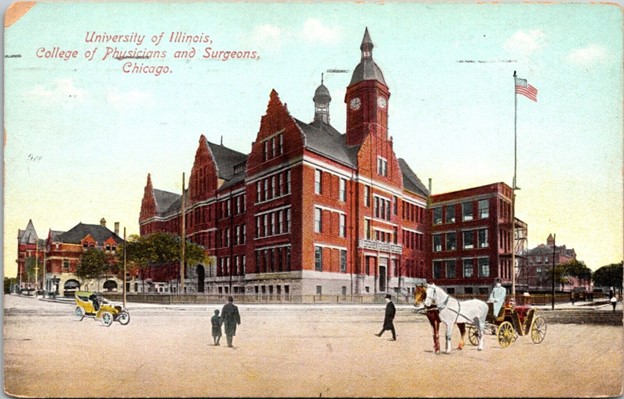
1881: College of Physicians & Surgeons of Chicago (to become University of Illinois College of Medicine) was established.
1882
1882: College of Physicians & Surgeons of Chicago opened its doors to 100 students with a faculty of 27 physicians at the corner of Harrison and Honore streets. Concurrently, a professorship of “Diseases of Children” was established; this was a forward-looking move because most other medical schools at the time combined pediatrics gynecology and obstetrics, e.g., “Professorship of Diseases of Women & Children.”
1885
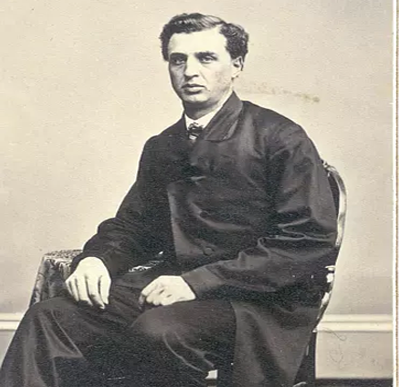
1885: Frank Waxham, who was the first to hold the chair of Diseases of Children, took over the technique of laryngeal intubation upon its introduction in 1885. His courageous advocacy of this initially unpopular method contributed to the preservation of many young lives in the virulent diphtheria epidemics of that pre-antitoxin era, when tracheotomy carried a mortality rate exceeding 60 percent. Other notable early faculty members included Walter S. Christopher, who pioneered in studies of the relationship between the physical condition of children and their intellectual capacity; and Charles Warrington Earle, the youngest of the school’s five founders, who went against prevailing public option to urge the germ theory of diphtheria etiology, promote the fact that typhoid fever could occur in babies and toddlers, and present ways that breast-feeding was superior in infant nutrition.
1893 - 1916

1893-1916: The West Side Field was home to the Chicago White Stockings, later the Cubs. The university purchased the property to consolidate its professional colleges and expand its medical education. The west tower of the new medical building was constructed on the approximate site of home plate.
-
1914
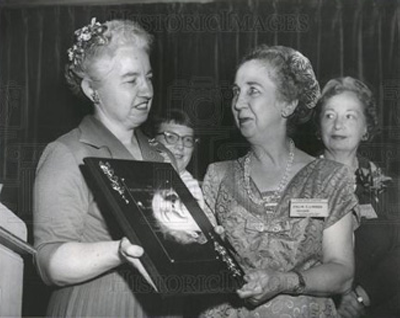
1914: Julius Hess , who designed the first commercially serviceable “incubator” (known throughout the world as the portable “Hess Bed”) and was considered the father of American neonatology, was named head of the pediatrics division in 1914 when pediatrics was part of the department of medicine. When an independent department of pediatrics was established in 1931, he became its first head and held that position until 1944. Dr. Hess’s scientific and clinical partner was Ms. Evelyn Lundeen (right in photo). Ms. Lundeen headed the first premature nursery in the United States. Beyond her work at the nursery, Lundeen traveled to other locations to teach methods of nursing care for premature infants. With Hess, she also co-authored an early textbook on premature baby care. In 1922, Hess published what may well be the first book dealing solely with premature and congenitally diseased infants; in the preface, he cited the expertise of Martin Courney, who turned premature babies into sideshow attractions at amusement parks worldwide as well as the Columbian Exposition of 1893 and the 1933 Century of Progress, both in Chicago. With funding from the Infant’s Aid Society, Dr. Hess opened one of the first infant stations in the United States for low birth-weight babies who had been born at home.
1928
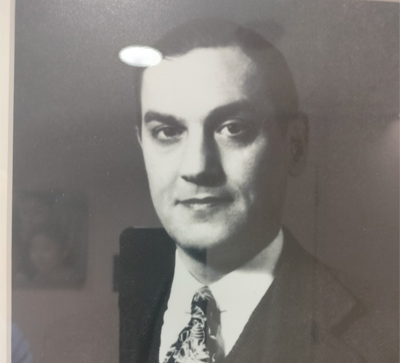
1928: First pediatric resident, Dr. Henry Poncher
1931
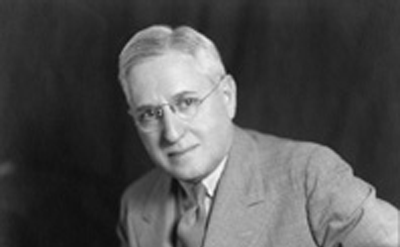
1931: Pediatrics achieves independent departmental status. Dr. Julius Hess is the first head. Hess was active in the medical community as a member of the American Medical Association, the American College of Physicians and the Central States Pediatrics Society. He published widely in medical journals. He served as president of the Illinois Medical Society between 1934 and 1935. He was head of the department of pediatrics for 30 years, retiring in 1944, when he received the title of professor emeritus of pediatrics. During the early 1950s he was involved with the medical advisory board for the National Foundation on Infantile Paralysis and their March of Dimes fundraiser for the treatment of polio. Hess was also a member of the Jewish Children’s Bureau. In 1952 the American Academy of Pediatrics presented him with their Borden Award for his contributions to the field. Hess wrote several books on medical subjects.
1935
1935: Grade A Pasteurization Milk Ordinance was unanimously adopted by the Chicago City Council in 1935. Also, Dr. Heyworth Sanford co-led a large-cohort epidemiology study that found breast-fed infants had lower mortality than “artificially”-fed infants.
1937
1937: The establishment of the Division of Services for Crippled Children (DSCC) in 1937, under the Maternal & Child Health Services amendment to the Social Security Act, marked the beginning of a long and fruitful affiliation that enhanced both UIC’s pediatrics programs and the care of Division patients. The DSCC came under UIC’s administration in 1957, a year after the creation of the Center for Handicapped Children.
1939
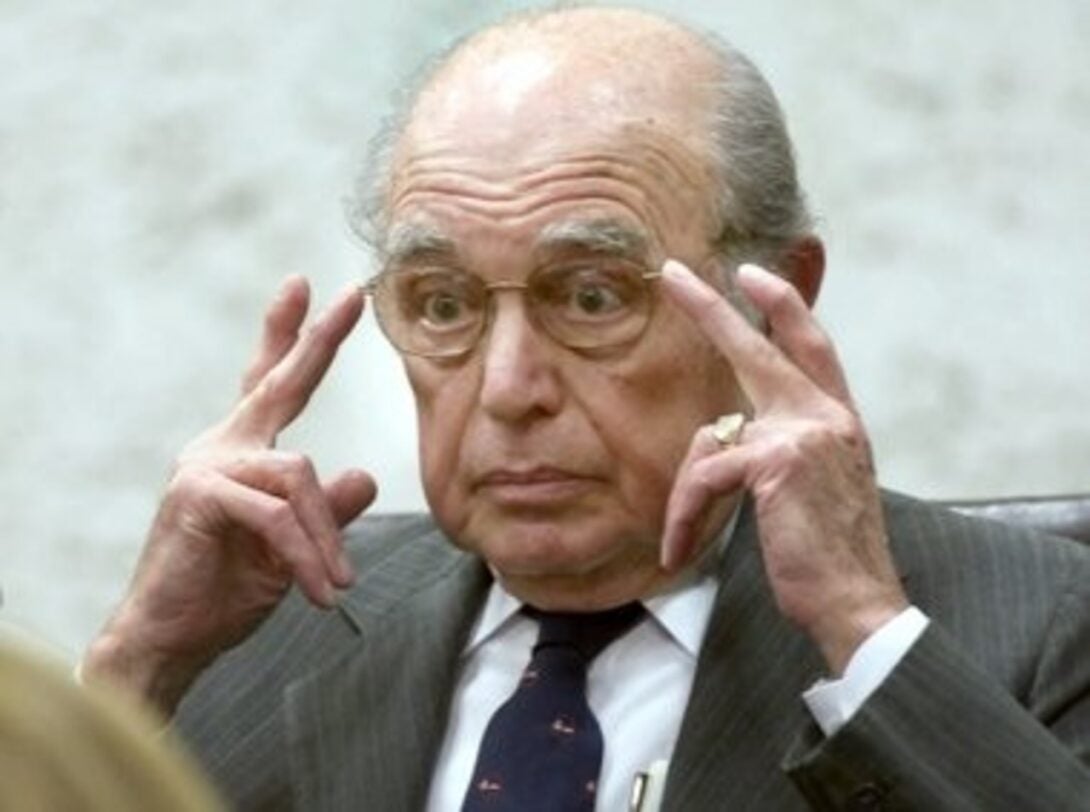
1939: Julius Richmond graduated from the College of Medicine at the University of Illinois at Chicago in 1939 and then joined the faculty and became the Superintendent for the Institute for Juvenile Research, where he conducted early childhood development studies. He was appointed as United States Surgeon General in 1977. His academic and political career included overseeing a new program called Project Head Start, sponsoring a series of Neighborhood Health Centers, establishing a Child Health Assurance Program, carrying out immunization campaigns and criticizing smoking as being a contributor to preventable disease.
1944 - 1952
1944-1952: Henry Poncher was head of the department of pediatrics. The years immediately following World War II were marked by residency training in Illinois expanding far more rapidly than clinical facilities. By rotating pediatric residents to services throughout the state, excellent education was provided as well as healthcare to many Illinois communities. Black physicians were recruited for graduate training under Provident Associates, and full-time instructors were hired.
1952 - 1961

1952-1961: Heyworth Sanford was head of the department of pediatrics.
1961-1972

1961-1972: Irving Schulman was head of the department of pediatrics; the department played a leading role in the development of chemotherapy for children with cancer. The fellowship in Hematology-Oncology attracted Dr. George Honig and Dr. Ruth Seeler. In 1965, Schulman was one of five U.S. physicians who comprised the first United States-Soviet Union Health Exchange Delegation, visiting several cities in the Soviet Union, including Moscow. In 1968, he received the John Fitzgerald Kennedy Memorial Award for Distinguished Service to Children from Georgetown University.
1965-1969
1965-1969: Julius Richmond worked in the “Great Society” programs of President Lyndon Johnson’s administration and founded Head Start and Federally Qualified Health Centers. Head Start grew from the research of Dr. Richmond on pre-schools at Syracuse University and earlier work here at the University of Illinois.
1967
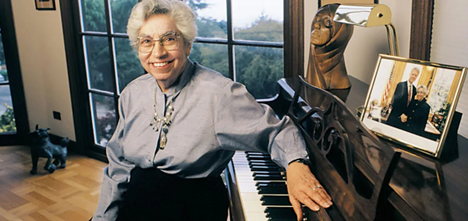
1967: The first Mile Square Health Center (MSHC) was founded by Joyce Lashof as a Federally Qualified Health Center as part of efforts to create neighborhood health centers under local control to reduce healthcare inequity. Dr. Lashof became the first woman to head a state public health department when she became IDPH director in 1973, establishing protocols to provide women access to safe abortion in Illinois. MSHC became part of UI Health in 1990, and the current location at Roosevelt & Wood opened in 2014.
1972
1972: Expansion of education and research programs included founding of the UIC Neonatal-Perinatal Medicine Fellowship Training Program in 1972. Also in 1972, thirty-eight students were admitted to UIC’s School of Public Health as its first class, with maternal and women’s health as among its areas of focus.
1973-1982
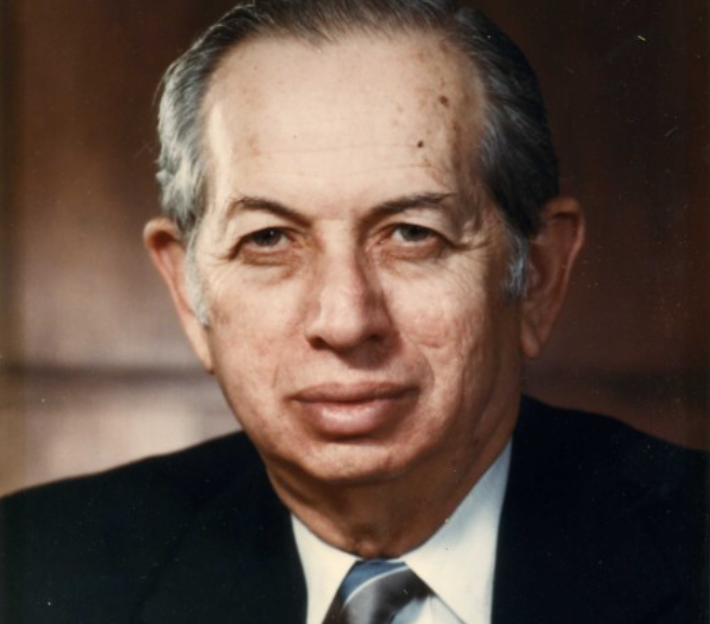
1973-1982: Ira Rosenthal was head of the department of pediatrics. Dr. Rosenthal made significant contributions to the city of Chicago and state of Illinois. He was founding member of the Advisory Committee on Genetics and Metabolism Diseases for the state. He participated in the activities of numerous other organizations, including local and national chapters of the March of Dimes. He was also president of the Chicago Pediatric Society. Among his many recognitions were the Raymond Allen Award, Brenneman Award, Albert Pisani Award, and Fomon Peterson Award. Students and doctors often turned to Dr. Rosenthal for his expertise in pediatric endocrinology, the study of child diabetes, growth hormones and thyroid problems.
1974
1974: As part of a plan completed by the Illinois Committee for Perinatal Health in 1974, five perinatal regions of service were created. High-risk infants and mothers were transported to UIC with guidelines developed collaboratively with the Emergency Medical Service and Highway Safety Department.
1980
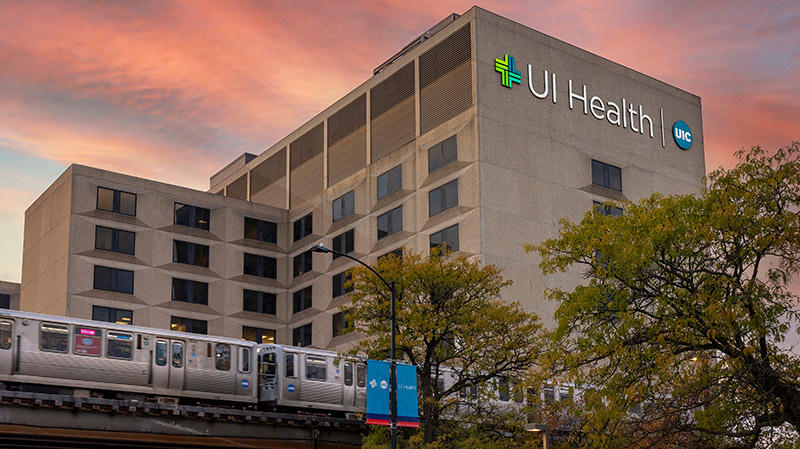
1980: UIC Hospital (now UI Health) opened at 1740 W Taylor St. Milestones of the hospital include the Mile Square Health Center (MSHC) becoming a part of UI Health in 1990. The Outpatient Care Center (OCC) opened on Taylor Street in 1999, housing more than 20 primary and specialty care clinics. In 2011, UI Health discovered a cure for Sickle Cell. The MSHC opened its doors to a new facility at Roosevelt Road and Wood Street in 2014, one of 13 MSHCs throughout Chicago. And in 2015, UI Health became a Joint Commission-accredited Comprehensive Stroke Center.
1982
1982: The Medical Center and Circle Campus consolidated to form UIC, making it a comprehensive research university. Richard J. Daley worked for nearly 30 years to make his vision of a publicly supported university in Chicago a reality, and he has been quoted as saying he considered UIC to be his greatest achievement in his 21 years as mayor (1955-76).
1984-2004
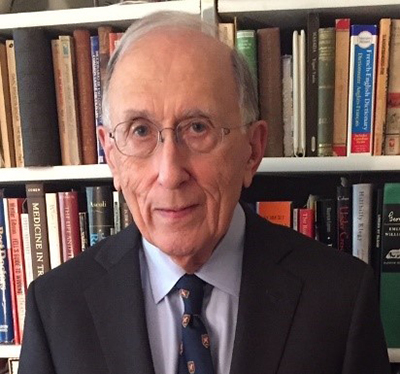
1984-2004: George Honig was head of the department of pediatrics. Co-founder of the University of Illinois Sickle Cell Center, he published numerous scholarly articles, book chapters on medicine and biomedical sciences, and scientific reports. He also wrote a novel entitled “The Alexandria Letter.”
1990s
1990s: UIC pediatrics faculty did seminal work on congenital heart disease diagnosis and repair. Examples of those on the team include Alois R. Hastreiter, who explored the treatment of heart failure or cardiac arrhythmias with digoxin; and Pedro del Nido, whose clinical interests include congenital valve reconstruction and research aims to design technology to facilitate beating heart repair of intra-cardiac defects.
1992
1992: George Honig founded a program to treat metabolic diseases in children that later expanded across Illinois and continued until his retirement in 2022.
1999
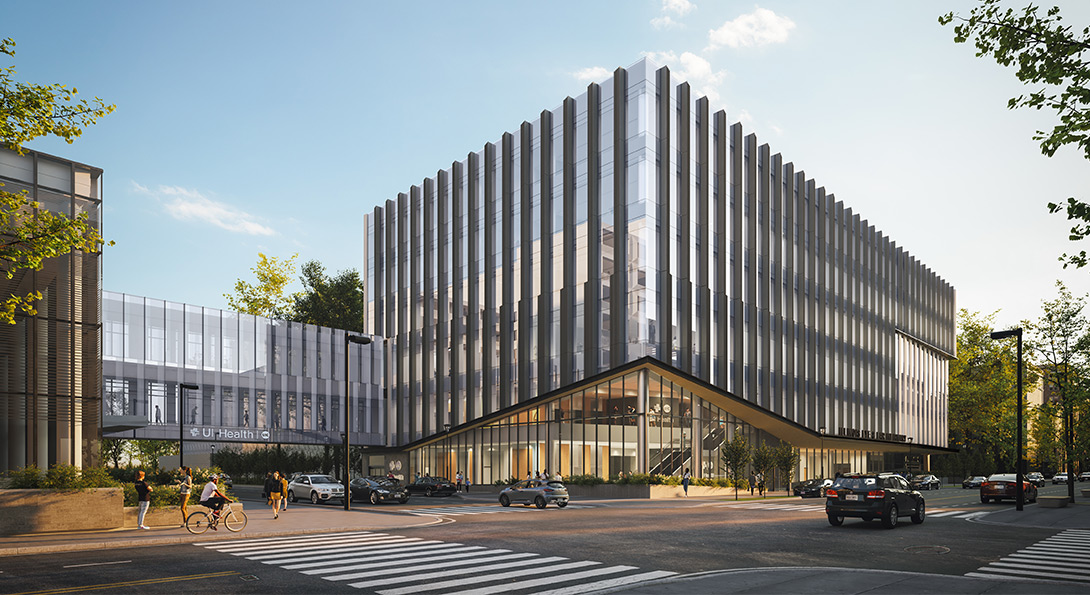
1999: The Outpatient Care Center opened on Taylor Street, now housing more than 20 primary and specialty care clinics that include the Child & Youth Center.
-
2002

2002: Eunice John worked with Enrico Benedetti to perform the first pediatric living-donor bowel transplant. Dr. John was also the first Chicago physician to start long-term peritoneal dialysis and use the double lumen catheter for hemodialysis in children in the early 1980s. She retired in 2018 after serving at UIC for 42 years, including as chief of pediatric nephrology and medical director of pediatric transplant.
2003-2004
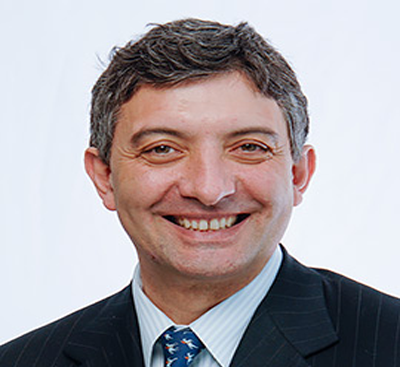
2003-2004: Kenneth C. Rich was interim head of the department of pediatrics. Under his leadership, UIC was established as a center for care of HIV infected children at the beginning of the perinatal HIV epidemic. This developed into participation in NIH sponsored studies in HIV pathogenesis and treatment, as well as epidemiologic studies of perinatal HIV infection.
2008-2015

2008-2015: Usha Raj was head of the department of pediatrics. Highlights of her leadership include establishment of two endowed professorships; re-establishment of bioscience, health services, and clinical research programs; addition of fellowship programs in three new areas; implementation of residency track and specialized curriculums; and the founding of Children’s Hospital University of Illinois. Multiple fellowships were added (Endocrinology, Adolescent Medicine) and a significant number of investigators recruited. The department’s research portfolio expanded and its Blue Ridge ranking improved to #66.
2011
2011: Children’s Hospital University of Illinois was opened as a “hospital within a hospital.” The building at 1740 W. Taylor St. was completed in 1980.
2014
2014: The Center for Medicare and Medicaid Services Healthcare Innovation Center awarded the University of Illinois a $19.5 million grant for the Coordination of Healthcare for Complex Kids (CHECK) program. The project, which targeted more than 6,000 children with Medicaid insurance, ultimately delivered more than 200,000 services and resulted in some 15 publications. It continues to the present (https://www.mycheck.uic.edu/).
-
2015-present
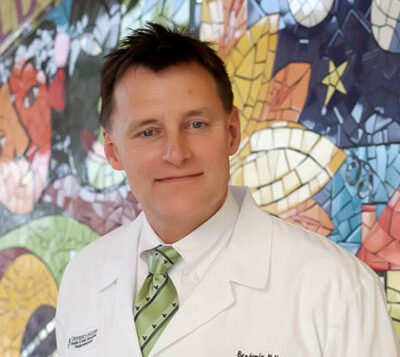
2015-present: As head of the Department of Pediatrics, Benjamin Van Voorhees initiated the development of the pediatrics program as a hub for child-health-services research; development of multi-disciplinary bioscience research; development of partnerships with Shriners Hospital for Children Chicago, Cook County Health, and Mile Square Health Center; and the creation and implementation of population health programs.
2015
2015: The University of Illinois and Shriners Hospital for Children Chicago inaugurated an affiliation that includes providing genetics and infectious disease services.
2017
2017: The Department of Pediatrics launched its first strategic plan with input from more than 120 stakeholders. The plan focused on developing partnerships in education, research and clinical care, expansion of access to care, and improvement in health outcomes for children under care.
2017-2018
2017-2018: The Pediatric Global Health group undertook delegations to hospitals in Ethiopia and Vietnam to exchange expertise.
2018
2018: The Clinical Leaders and Academic Scholars Fellowship was founded by Drs. Saul Weiner and Milan Albarki-Micou to train pediatricians, internists, and family physicians for leadership roles in academic medicine.
2020
2020: UI Child Health and Pediatric Clinical Council formed to coordinate child-health clinical activities across UIH. The council includes all departments, colleges and facilities caring for children. Similarly, child-health listserv news and update program started encompassing more than 350 physician, nurse and administrative professionals caring for children at UIH.
2021
2021: The Sit Down and Play intervention, which was developed in a study by University of Illinois researchers, was expanded to India. The project focuses on strengthening parent-child interactions to improve developmental outcomes.
2021
2021: The University of Illinois and Cook County Health formed the Partnership for Pediatric Care to improve access to care, reduce health care costs, and improve outcomes for children in Cook County.
2021
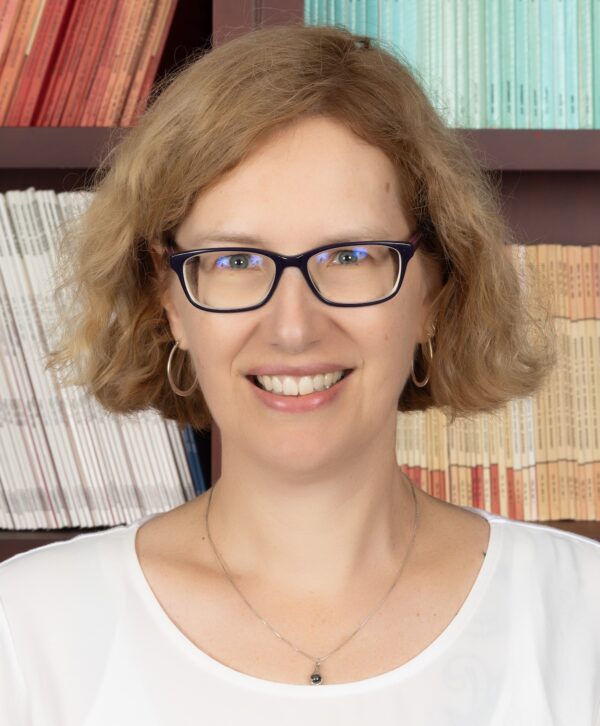
2021: The University of Illinois Chicago Child and Adolescent Health Research Consortium was founded by Dr. Molly Martin and Dr. David Dubois.
2022
2022: Health services research was expanded at the UI Health with two Patient Centered Outcome Research Institute and several National Institute of Health grants to address obesity, asthma, mental health, and oral disease. Partnerships expanded with the Division of Specialized Care of Children and with the Department of Human Development and Disability.
2022

2022: Dr. Xiao-Di Tan founded the Center for Translation Pediatric Research and Education.
2023
2023: The Department of Pediatrics started its second strategic plan, which focuses on expanding the Partnership for Pediatric Care with Cook County Health and growing research collaborations across the university.
2024
2024: Childrens Hospital University of Illinois was rated in six specialties by a US News & World Report Children’s Hospital survey and as #23 in the Midwest. The Department’s Blue Ridge Ranking (National Institute of Health funding) improved to #42.